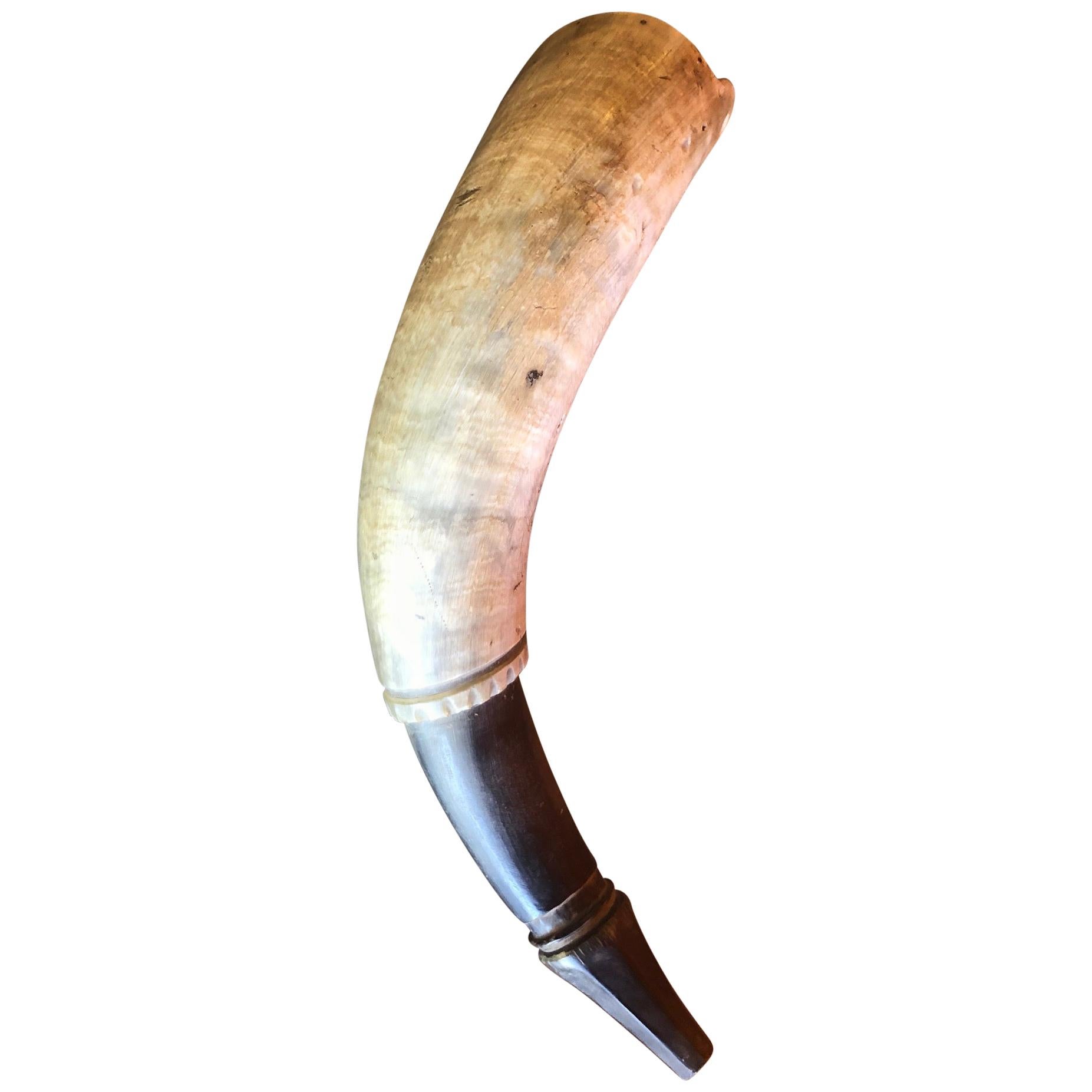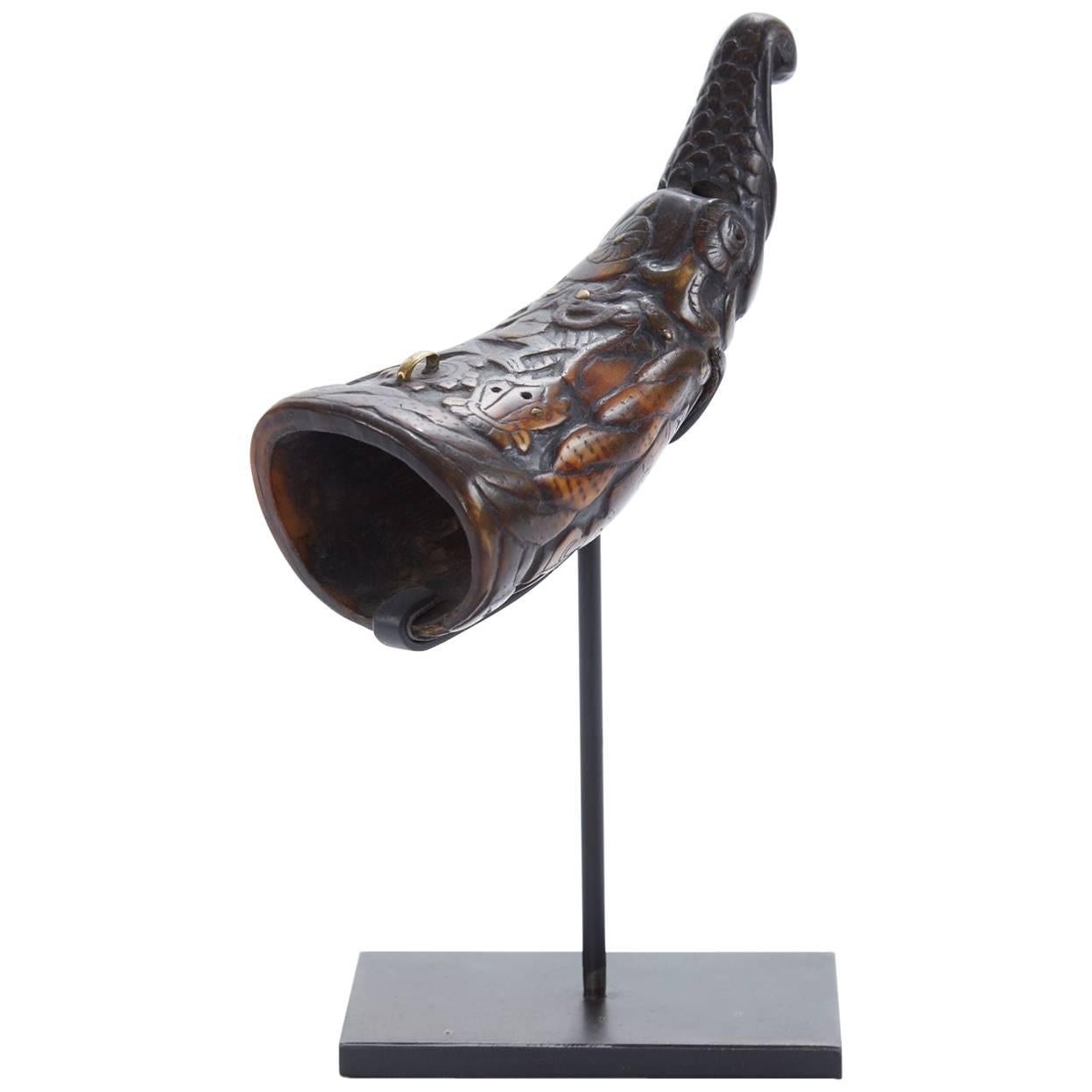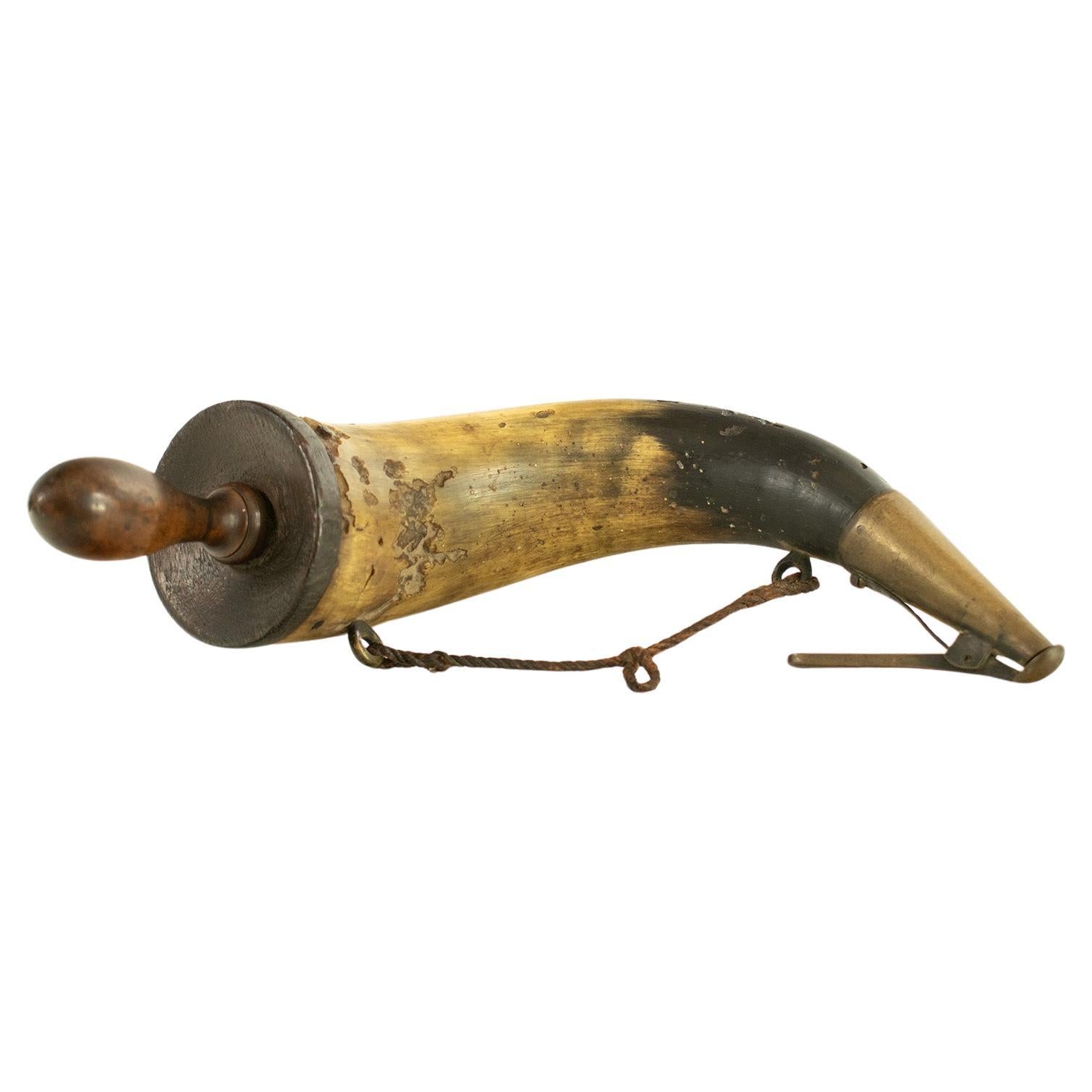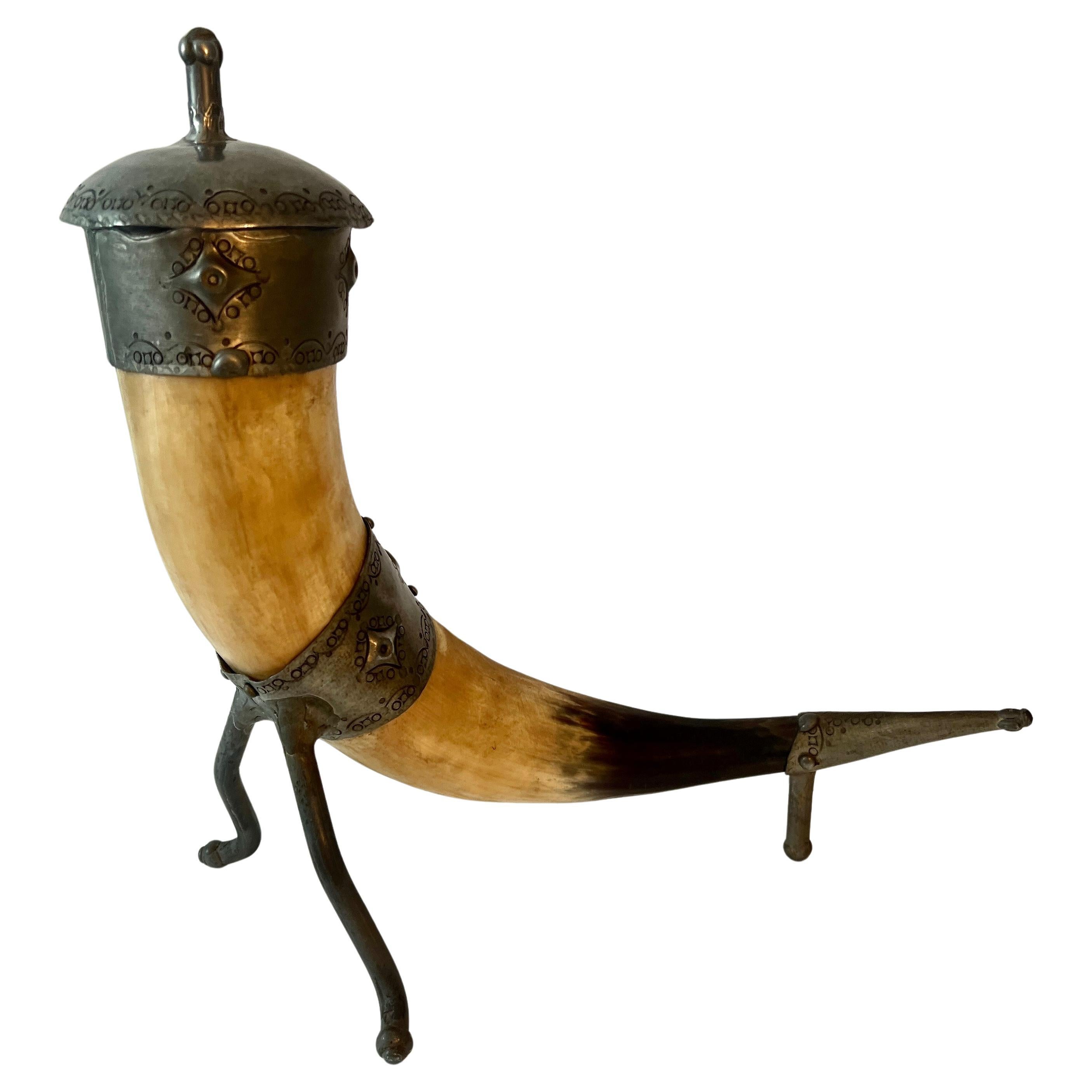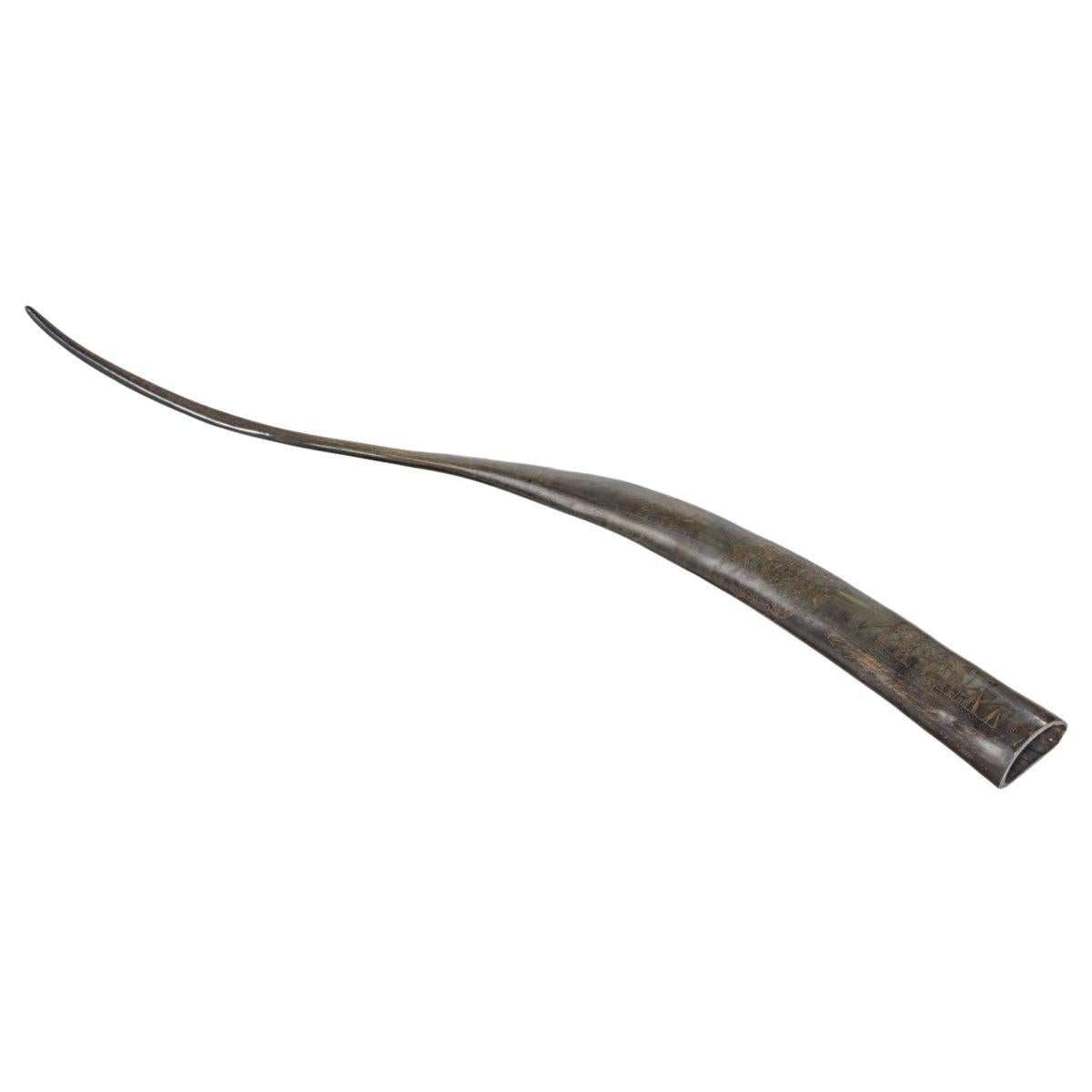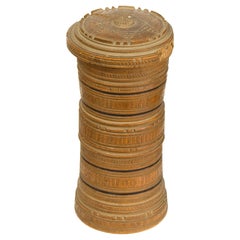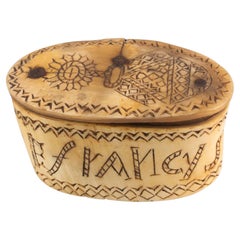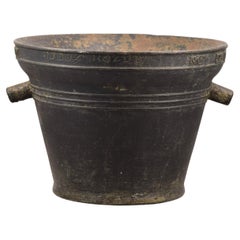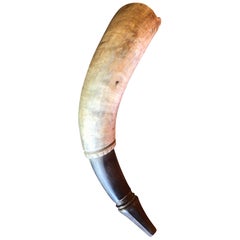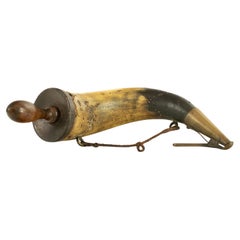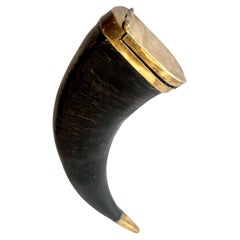Items Similar to Powder keg. Engraved horn, rope, cork. Spain, 19th century.
Want more images or videos?
Request additional images or videos from the seller
1 of 8
Powder keg. Engraved horn, rope, cork. Spain, 19th century.
$1,798.77
£1,338.10
€1,500
CA$2,463.13
A$2,738.66
CHF 1,429.98
MX$33,336.21
NOK 18,245.91
SEK 17,095.55
DKK 11,418.67
Shipping
Retrieving quote...The 1stDibs Promise:
Authenticity Guarantee,
Money-Back Guarantee,
24-Hour Cancellation
About the Item
Powder keg. Engraved horn, rope, cork. Spain, 19th century.
A container for storing gunpowder made from a cow's horn and decorated on the outside with a series of figurative, geometric and vegetal engravings and inscriptions enhanced with dark or black ink or dye. The decoration is arranged in horizontal bands, with some elements enhanced with "frames" of crossed lines, and one can clearly see Latin crosses, floral elements, a coiled snake, various human figures (note in particular the male figures at the top, with firearms), quadrupeds, birds, fish and inscriptions in capital letters (names such as Manuel, intertwined initials...). Also known as “horns”, these types of vessels were usually made not by skilled and specialized workers, but by shepherds, ranchers, etc., using their own names, important elements from their area or for themselves, or motifs of great tradition in a certain area in their decoration. Compare this with the one by Pedro Doncel, dated 1855 and preserved in the Museum of Olivenza (Spain), or the one from 1883 in the Museo del Traje in Madrid (Spain). ·
Size: 27x8x7 cms
International Buyers – Please Note: for those articles that need Export Permits (those older than 100 years), the obtaining of the Permit will be processed without additional expenses (if you choose the seller sends it to you), but the period for the obtention of it may vary from 10 to 35 days.
- Dimensions:Height: 2.76 in (7 cm)Width: 3.15 in (8 cm)Depth: 10.63 in (27 cm)
- Style:Neoclassical Revival (Of the Period)
- Materials and Techniques:
- Place of Origin:
- Period:
- Date of Manufacture:19th century
- Condition:Wear consistent with age and use. Minor losses. Minor fading.
- Seller Location:Madrid, ES
- Reference Number:Seller: zf12861stDibs: LU2951341339172
About the Seller
4.9
Vetted Professional Seller
Every seller passes strict standards for authenticity and reliability
Established in 1985
1stDibs seller since 2017
346 sales on 1stDibs
Typical response time: 8 hours
- ShippingRetrieving quote...Shipping from: MADRID, Spain
- Return Policy
Authenticity Guarantee
In the unlikely event there’s an issue with an item’s authenticity, contact us within 1 year for a full refund. DetailsMoney-Back Guarantee
If your item is not as described, is damaged in transit, or does not arrive, contact us within 7 days for a full refund. Details24-Hour Cancellation
You have a 24-hour grace period in which to reconsider your purchase, with no questions asked.Vetted Professional Sellers
Our world-class sellers must adhere to strict standards for service and quality, maintaining the integrity of our listings.Price-Match Guarantee
If you find that a seller listed the same item for a lower price elsewhere, we’ll match it.Trusted Global Delivery
Our best-in-class carrier network provides specialized shipping options worldwide, including custom delivery.More From This Seller
View AllWood Turner Test Cilindrical Box, 17th-18th Centuries
Located in Madrid, ES
Cylindrical box of "turner's test", 17th-18th century.
Cylindrical box decorated with different bands and lid with a carved star. In the bse it presents a series of inscriptions t...
Category
Antique 18th Century European Other Decorative Boxes
Materials
Wood
Shepherd's box or snuff box. Carved antler or horn. Spain, 1861.
Located in Madrid, ES
Pastoral box. Carved antler, wood, metal. Spanish school, 1861.
Submit registrations.
Oval box made of antler carved in its color, with wood on the lid to reinforce it, decorated o...
Category
Antique 1860s Spanish Neoclassical Revival Snuff Boxes and Tobacco Boxes
Materials
Other
Shepherd Box, Carved Horn or Antler, Spain, 1822
Located in Madrid, ES
Shepherd box. Carved horn. Spain, 1822.
Rectangular box made of carved horn that has a date (1822) engraved on the lid and front, a legend (Soi de Manuel Zulueta year 1822) and an...
Category
Antique 1820s Neoclassical Snuff Boxes and Tobacco Boxes
Materials
Other
Mortar with Inscriptions. Bronze, Spain, 1823
Located in Madrid, ES
Mortar with inscriptions. Bronze. Spain, 1823.
Con maza.
Mortar made of bronze with an enlarged mouth and a cone shaped body developed without discontinuity and with a decreasing diameter to the base; It has two handles or "pieces" towards the smooth decorative moldings that it has on the upper part. The piece presents, almost on the edge, an inscription (I AM FROM D GREGORIO OCANA ANO DE 1823) in capital letters and a date in roman with spaces between them; and the text (the other way around) “Mazon fecci”; both flanked by a simple molding above and another below.
This large-sized mortar is of the type that is usually known as "hospital" because it is usually used for medicines in environments with many patients or in important apothecaries. Typologically, it follows the usual line in these examples of the Spanish school during the 19th century: smooth, with moldings and, as a general rule, without those ribs (or derivatives thereof) that used to appear in the previous ones. Compare, for example, with the large pharmacy mortar in the Municipal Museum-Archive of Calella (with inscription, ribs and human heads as handles), a large pestle...
Category
Antique 1820s Spanish Neoclassical Revival Scientific Instruments
Materials
Bronze
Oinochoe. Bronze. Possibly Italy, 19th century.
Located in Madrid, ES
Oinochoe. Bronze. Possibly Italy, 19th century.
An oenochoe, oinochoe, oinochoe or oenochoe is a vessel used to draw wine from a krater (where it was stored) before serving in ancie...
Category
Antique 19th Century European Neoclassical Revival Vases
Materials
Bronze
Bronze Mortar with Inscription, Spain, 1816
Located in Madrid, ES
Pharmacy mortar. Bronze. Spain, 1816.
Mortar with an excavated mouth, decoration of derived ribs in pilasters and a stripe in the upper area with an inscription (I am from Don Juan Antonio...
Category
Antique 1810s Spanish Neoclassical Revival Scientific Instruments
Materials
Bronze
You May Also Like
19th Century Antique Powder Horn with Scrimshaw
Located in San Diego, CA
Rare 19th century antique powder horn with scrimshaw, circa 1872. The horn is inscribed "Charles Lee" in scroll on the side of the horn and the woo...
Category
Antique Mid-19th Century American Folk Art Sculptures and Carvings
Materials
Metal
$1,200 Sale Price
20% Off
Late 19th Century Hand-Carved ritual 'Thun Rwa' Horn with Gold Inlay
Located in Chicago, IL
Late 19th century hand-carved 'Thun Rwa' horn was used commonly by the Ngakpa (lay Lamas) of Tibet. Used as a healing tool with medicinal/herbal powders, the tribe "Medicine Man" wou...
Category
Antique Late 19th Century Burkinabe Mounted Objects
Materials
Gold
LARGE GUNNER'S POWDER HORN Naval - French, late 18th century.
Located in TEYJAT, FR
Original Large French Gunner's Powder Horn, Naval - French, late 18th century. Of large size used to load cannons aboard ship.
With fitted wooden plug and brass dispensing spout.
T...
Category
Antique 19th Century Arms, Armor and Weapons
Materials
Horn, Wood
Decorative Horn with Brass Closure and Brass Tip for Storage, Drinking, 420
Located in Los Angeles, CA
A beautiful horn - typically used as a drinking cup on the camp, or storage of anything from gunpowder to tobacco - today, with the addition of a beaurtiful brass hinged top and adde...
Category
20th Century English Rustic Tribal Art
Materials
Brass
19th Century Lidded Vessel or Sculptural Horn Decorated with Etched Pewter
Located in Los Angeles, CA
A wonderful Horn resting on three hand wrought pewter legs with a tip, collar and lid with hand crafted etching and details.
The horn is a compliment to any shelf, console table - a...
Category
Antique 19th Century Rustic Natural Specimens
Materials
Pewter
Rare Scrimshaw Decorated Horn
Located in Lymington, Hampshire
A rare scrimshaw decorated horn, engraved over one side with the Royal Arms countersigned and titled ship profiles for the Great Eastern, the Great Britain,...
Category
Antique 1860s English Nautical Objects
Materials
Horn
